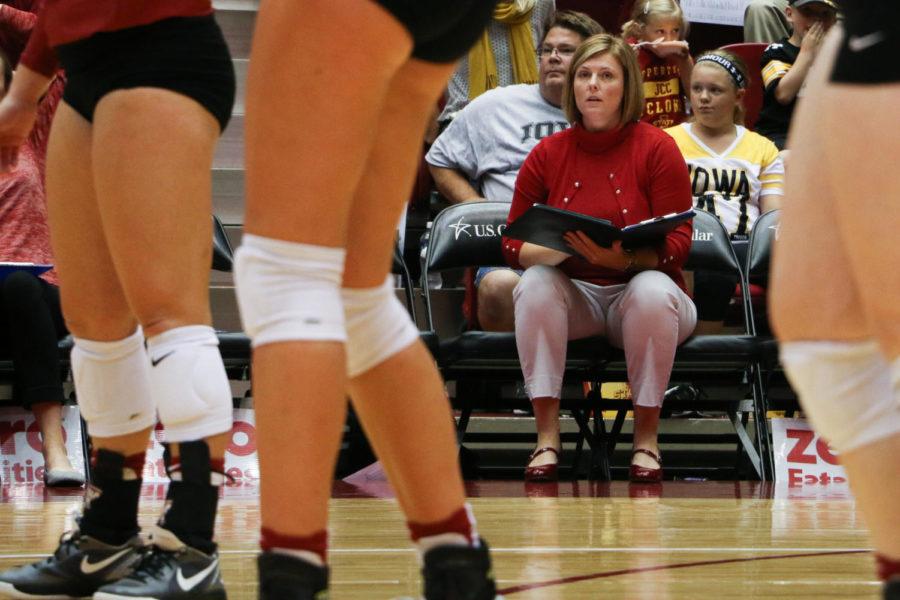The swing block: Iowa State’s key to a hot start
September 18, 2017
In Christy Johnson-Lynch’s tenure as the Cyclone volleyball coach, the Iowa State faithful have witnessed a plethora of blocks, but the blocks have been more sparse recently.
From 2005 to 2011, Johnson-Lynch’s first seven seasons, Iowa State out-blocked its opponents, averaging about 311 blocks per season and 2.7 blocks per set.
How did the Cyclones fare the next four seasons? Their numbers plummeted. Over the stretch, Iowa State averaged about 197 blocks per season and 1.8 blocks per set.
Iowa State has flipped the script this year. Currently, the Cyclones have compiled 118 blocks this season, averaging 3.2 blocks per set.
At that rate, Iowa State is on pace to finish with over 300 blocks on the season. The last time the Cyclones reached that 300 block threshold was in 2007, Johnson-Lynch’s third season at Iowa State.
Johnson-Lynch has been pleased with her team’s defense early on in the season.
“Our defense and blocking continue to be strong,” Johnson-Lynch said. “When we’re on, we’re smothering opponents.”
It’s worth noting that in the first 10 matches, the Cyclones haven’t faced any Big 12 schools and they’ve played a handful of small schools. Could it be that the lack of competition is padding the stats?
When Iowa State played No. 8 Creighton, the Cyclones had a season-high 15 blocks. Against Atlantic Coast Conference and Big 10 schools Pittsburgh and Iowa, Iowa State compiled 14 blocks in each match.
Against smaller schools like Omaha, New Mexico and Northern Illinois, Iowa State had 10 or fewer blocks. The lack of blocks against smaller schools could be credited to the length of the matches.
Iowa State has swept six opponents this season. None of those six have been from a power five conference. The less competition there is, the quicker the matches go, providing less opportunities for blocks.
The Cyclones have proven they can block big schools and little schools, but what ignited this change in the Iowa State defense?
“I think switching to the swing block [is important],” said Grace Lazard, junior middle blocker. “I think that’s really helped us a lot. Everyone’s practicing it. We’re all getting better at it.”
The swing block is a more aggressive block and is harder to master, but it provides benefits that a traditional block doesn’t.
“Swing blocking helps you to be able to move further across the net,” Johnson-Lynch said. “Swing blocking helps you be more athletic [and] use your athleticism to go block the ball.”
The downfall of swing blocking is that with more motion in the swing block than a traditional block, it can affect a blocker’s balance.
Lazard envisions Iowa State’s swing blocking will to continue to improve and become unstoppable to opponents.
“I feel like a strong team is a good team that can swing block really, really well,” Lazard said. “I think if we continue to keep it up and keep getting stronger, honestly, we’ll literally be a brick wall.”
In the past, Iowa State utilized the traditional blocking style, called the stationary block, before transitioning to the swing block.
“We did stationary blocking [previously], where you just stay in a spot, and you just jump,” said Samara West, redshirt senior blocker. “I feel like swing blocking, it’s basically kind of like you’re approaching and then you’re getting up and it just makes you be more dynamic [and] big.”
There’s been some growing pains with the swing block, but it looks like the amount of time spent toward the transition is paying off.
“No matter what system [you use], if you commit a lot of time to it, you’re going to get a lot better at it,” Johnson-Lynch said. “I think we’ve just committed a lot of time to blocking.”
For some players, it was less of an adjustment than for others.
With the complexity of the swing block, a lot of high schools steer away from the technique.
Freshman middle blocker Avery Rhodes attended Midway High School in Waco, Texas, one of the top volleyball high schools in the nation. The elite level of Midway High School allowed Rhodes to develop her swing block in high school.
“I was taught [the swing block] in high school, so it’s like second nature,” Rhodes said.
Not everyone on the team has the background with swing blocking like Rhodes, but it appears the others are willing to learn the new skill.
When a coach decides to change players’ techniques or a team’s scheme, sometimes the players won’t be on the same page. Not only have the blockers bought in, but the other positions are on board too.
“[Swing blocking] makes us more so much more dynamic and physical,” said Monique Harris, senior setter. “It’s clearly shown, it’s a huge advantage for us and moving to that swing block has been huge.”
The small sample size of this year’s swing blocking has helped Iowa State jump out to a 9-1 start and the No. 18 spot in the American Volleyball Coaches Association’s Top 25.







